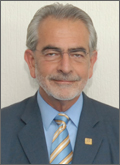210th ECS Meeting | Cancun, Mexico | Oct. 30, 2006

Science and Technology Policy in Mexico for the 21st Century
The plenary talk was given by José Luis Fernández Zayas on “Science and Technology Policy in Mexico for the 21st Century.” Dr. Fernández Zayas is a senior researcher at the Institute of Engineering of the National Autonomous University of Mexico (UNAM). The speaker started out with historical perspectives on Mexico’s science and technology (S&T) policy through the years. Until the 19th century, the country had adopted an isolationist stance and resisted external influences. This softened somewhat in the 20th century and the economy did not open up till NAFTA was signed some 20 years ago. The challenges with having an S&T giant (i.e., U.S.A.) just north of the border have been considerable in Mexico’s attempts to make up lost ground in technological competitiveness with the rest of the advanced world. In particular, the brain drain of trained scientists, engineers, and professionals from Mexico to the U.S. has been a crucial problem.
Dr. Fernández Zayas showed data on how poorly Mexico fared relative to other countries, in terms of the number of scientists and engineers, as a function of R&D expenditures in units of %GNP. Countries like the U.S. and Finland were at the top of this chart. The speaker then charted out strategies for improving the technological competitiveness of Mexico. He referred to a linear model that relies on the progression from science to technology to innovation, leading ultimately to competitiveness in the market arena. Value is added to knowledge at each stage in this progression (i.e., creating a “knowledge economy”). A major problem with Mexico is that the vast majority of the jobs are “low-tech” and do not create wealth. The challenge then for Mexico for the 21st century is to increase the financial return per unit of labor input; and this can only be done by raising the level of education and the technological awareness among a much greater swath of the population.
Dr. Fernández Zayas then turned to a discussion of the strategic technical areas targeted by the new government policy makers. These include materials, biotech (genomics), software and wireless, and advanced manufacture. Sustainable development, with particular attention to societal needs, would be one cornerstone of this new S&T policy. He identified the three axes of this policy as promoting S&T in the new to medium term balanced with cultural and economic initiatives, creation of new and better quality (high-tech) jobs that create substantial wealth (the Silicon Valley model), and the development of new and successful social/education schemes to bring up the poor and disadvantaged sections of the Mexican society.
Many of the points addressed in this interesting lecture could have been easily transposed to any developing nation but the speaker was particularly effective in reminding the audience that Mexico was looking to her neighbor for collaboration and co-operation rather than pity, in her quest to achieve technological competitiveness in a global economy.
